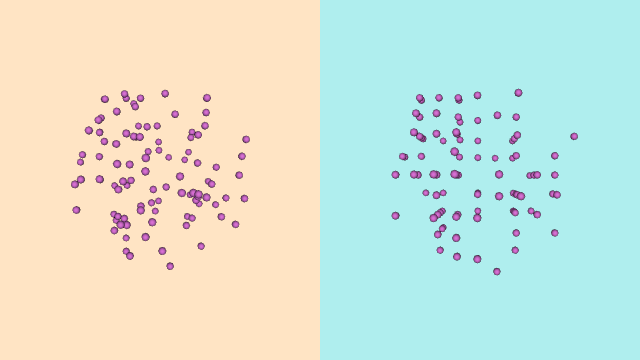QuantizePolyDataPoints
vtk-examples/Cxx/PolyData/QuantizePolyDataPoints
Description¶
This example demonstrates how to "snap" points onto a discrete grid. This example rounds the coordinates of each point the the nearest 0.1
Question
If you have a question about this example, please use the VTK Discourse Forum
Code¶
QuantizePolyDataPoints.cxx
#include <vtkCamera.h>
#include <vtkGlyph3DMapper.h>
#include <vtkNamedColors.h>
#include <vtkNew.h>
#include <vtkPointSource.h>
#include <vtkPoints.h>
#include <vtkPolyData.h>
#include <vtkProperty.h>
#include <vtkQuantizePolyDataPoints.h>
#include <vtkRenderWindow.h>
#include <vtkRenderWindowInteractor.h>
#include <vtkRenderer.h>
#include <vtkSphereSource.h>
#include <iostream>
#include <string>
int main(int, char*[])
{
vtkNew<vtkNamedColors> colors;
vtkNew<vtkPointSource> pointSource;
pointSource->SetNumberOfPoints(100);
pointSource->Update();
std::cout << "There are " << pointSource->GetNumberOfPoints() << " points."
<< std::endl;
vtkNew<vtkQuantizePolyDataPoints> quantizeFilter;
quantizeFilter->SetInputConnection(pointSource->GetOutputPort());
quantizeFilter->SetQFactor(.1);
quantizeFilter->Update();
vtkPolyData* quantized = quantizeFilter->GetOutput();
std::cout << "There are " << quantized->GetNumberOfPoints()
<< " quantized points." << std::endl;
for (vtkIdType i = 0; i < pointSource->GetOutput()->GetNumberOfPoints(); i++)
{
double pOrig[3];
double pQuantized[3];
pointSource->GetOutput()->GetPoint(i, pOrig);
quantized->GetPoints()->GetPoint(i, pQuantized);
std::cout << "Point " << i << " : (" << pOrig[0] << ", " << pOrig[1] << ", "
<< pOrig[2] << ")"
<< " (" << pQuantized[0] << ", " << pQuantized[1] << ", "
<< pQuantized[2] << ")" << std::endl;
}
double radius = 0.02;
vtkNew<vtkSphereSource> sphereSource;
sphereSource->SetRadius(radius);
vtkNew<vtkGlyph3DMapper> inputMapper;
inputMapper->SetInputConnection(pointSource->GetOutputPort());
inputMapper->SetSourceConnection(sphereSource->GetOutputPort());
inputMapper->ScalarVisibilityOff();
inputMapper->ScalingOff();
vtkNew<vtkActor> inputActor;
inputActor->SetMapper(inputMapper);
inputActor->GetProperty()->SetColor(colors->GetColor3d("Orchid").GetData());
vtkNew<vtkGlyph3DMapper> quantizedMapper;
quantizedMapper->SetInputConnection(quantizeFilter->GetOutputPort());
quantizedMapper->SetSourceConnection(sphereSource->GetOutputPort());
quantizedMapper->ScalarVisibilityOff();
quantizedMapper->ScalingOff();
vtkNew<vtkActor> quantizedActor;
quantizedActor->SetMapper(quantizedMapper);
quantizedActor->GetProperty()->SetColor(
colors->GetColor3d("Orchid").GetData());
// There will be one render window
vtkNew<vtkRenderWindow> renderWindow;
renderWindow->SetSize(640, 360);
// And one interactor
vtkNew<vtkRenderWindowInteractor> interactor;
interactor->SetRenderWindow(renderWindow);
renderWindow->SetWindowName("QuantizePolyDataPoints");
// Define viewport ranges.
// (xmin, ymin, xmax, ymax)
double leftViewport[4] = {0.0, 0.0, 0.5, 1.0};
double rightViewport[4] = {0.5, 0.0, 1.0, 1.0};
// Setup both renderers.
vtkNew<vtkRenderer> leftRenderer;
renderWindow->AddRenderer(leftRenderer);
leftRenderer->SetViewport(leftViewport);
leftRenderer->SetBackground(colors->GetColor3d("Bisque").GetData());
vtkNew<vtkRenderer> rightRenderer;
renderWindow->AddRenderer(rightRenderer);
rightRenderer->SetViewport(rightViewport);
rightRenderer->SetBackground(colors->GetColor3d("PaleTurquoise").GetData());
leftRenderer->AddActor(inputActor);
rightRenderer->AddActor(quantizedActor);
leftRenderer->ResetCamera();
rightRenderer->SetActiveCamera(leftRenderer->GetActiveCamera());
renderWindow->Render();
interactor->Start();
return EXIT_SUCCESS;
}
CMakeLists.txt¶
cmake_minimum_required(VERSION 3.12 FATAL_ERROR)
project(QuantizePolyDataPoints)
find_package(VTK COMPONENTS
CommonColor
CommonCore
CommonDataModel
FiltersGeneral
FiltersSources
InteractionStyle
RenderingContextOpenGL2
RenderingCore
RenderingFreeType
RenderingGL2PSOpenGL2
RenderingOpenGL2
)
if (NOT VTK_FOUND)
message(FATAL_ERROR "QuantizePolyDataPoints: Unable to find the VTK build folder.")
endif()
# Prevent a "command line is too long" failure in Windows.
set(CMAKE_NINJA_FORCE_RESPONSE_FILE "ON" CACHE BOOL "Force Ninja to use response files.")
add_executable(QuantizePolyDataPoints MACOSX_BUNDLE QuantizePolyDataPoints.cxx )
target_link_libraries(QuantizePolyDataPoints PRIVATE ${VTK_LIBRARIES}
)
# vtk_module_autoinit is needed
vtk_module_autoinit(
TARGETS QuantizePolyDataPoints
MODULES ${VTK_LIBRARIES}
)
Download and Build QuantizePolyDataPoints¶
Click here to download QuantizePolyDataPoints and its CMakeLists.txt file. Once the tarball QuantizePolyDataPoints.tar has been downloaded and extracted,
cd QuantizePolyDataPoints/build
If VTK is installed:
cmake ..
If VTK is not installed but compiled on your system, you will need to specify the path to your VTK build:
cmake -DVTK_DIR:PATH=/home/me/vtk_build ..
Build the project:
make
and run it:
./QuantizePolyDataPoints
WINDOWS USERS
Be sure to add the VTK bin directory to your path. This will resolve the VTK dll's at run time.
